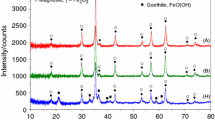Abstract
The structural and magnetic properties of the mesoporous systems based on silicon dioxide with a regular hexagonal arrangement of pores several microns in length and several nanometers in diameter, which are filled with iron compound nanofilaments in various chemical states, are studied in detail. The studies are performed using the following mutually complementary methods: transmission electron microscopy, SQUID magnetometry, electron spin resonance, Mössbauer spectroscopy, polarized neutron small-angle diffraction, and synchrotron radiation diffraction. It is shown that the iron nanoparticles in pores are mainly in the γ phase of Fe2O3 with a small addition of the α phase and atomic iron clusters. The effective magnetic field acting on a nanofilament from other nanofilaments is 11 mT and has a dipole nature, the ferromagnetic–paramagnetic transition temperature is in the range 76–94 K depending on the annealing temperature of the samples, and the temperature that corresponds to the change in the magnetic state of the iron oxide nanofilaments is T ≈ 50–60 K at H = 0 and T ≈ 80 K at H = 300 mT. It is also shown that the magnetization reversal of an array of nanofilaments is caused by the magnetostatic interaction between nanofilaments at the fields that are lower than the saturation field.
Similar content being viewed by others
References
A. K. Menon and B. K. Gupta, Nanostruct. Mater. 11, 965 (1999).
L. Thomas, F. Lionty, R. Ballou, et al., Nature 383, 145 (1996).
J. S. Beck, J. C. Vartuli, W. J. Roth, et al., J. Am. Chem. Soc. 114, 10834 (1992).
G. De, L. Tapfer, M. Catalano, et al., Appl. Phys. Lett. 68, 3820 (1996).
K. S. Napolsky, A. A. Eliseev, A. V. Knotko, et al., Mater. Sci. Eng. C 23, 151 (2003).
J. Cheon, K.-B. Lee, H. Kang, et al., in Proceedings of the MRS Symposium on Anisotropic Nanoparticles: Synthesis, Characterization and Applications, Boston, MA, 2000, p. 635.
R. Zboril, M. Mashlan, and D. Petridis, Chem. Mater. 14, 969 (2002).
R. Zboril, M. Mashlan, D. Krausova, et al., Hyperfine Interact. 120–121, 497 (1999).
R. Skomskii and J. M. D. Coey, Permanent Magnetism (Inst. Phys., Bristol, UK, 1999).
R. D. Zusler, M. Vasquez-Mansilla, C. Arciprete, et al., J. Magn. Magn. Mater. 224, 39 (2001).
C. G. Shull, W. A. Strauser, and E. O. Wollan, Phys. Rev. B 83, 333 (1951).
C. Guilland, J. Phys. Radium. 12, 489 (1951).
N. Amin and S. Arajs, Phys. Rev. B 35, 4810 (1987).
A. B. Bourlinos, A. Simopoulos, and D. Petridis, Chem. Mater. 14, 899 (2002).
G. Ennas, A. Musinu, G. Piccaluga, et al., Chem. Mater. 10, 495 (1998).
C. Cannas, M. F. Casula, G. Concas, et al., J. Mater. Chem. 11, 3180 (2001).
http://www.esrf.eu/computing/scientific/FIT2D/.
http://www.cdifx.univ-rennes1.fr/winplotr/.
C. P. Jaroniec, R. K. Gilpin, and M. Jaroniec, J. Phys. Chem. B 101, 6861 (1997).
R. K. Iler, The Chemistry of Silica (Wiley, New York, 1979).
C. T. Hseih, W. L. Huang, and J. T. Lue, J. Phys. Chem. Solidi 63, 733 (2002).
R. D. Shull, J. J. Ritter, and L. J. Swartzendruber, J. Appl. Phys. 69, 5144 (1991).
B. Bleaney and K. W. H. Stevens, Rep. Progr. Phys. 16, 108 (1953).
B. Bleaney, London, Edinburgh, Dublin Philos. Mag. J. Sci. 42, 328 (1951).
A. Abraham and B. Bleaney, Electron Paramagnetic Resonance of Transition Ions (Clarendon, Oxford, 1970; Mir, Moscow, 1973).
S. R. Kurkjian and E. A. Sigety, Phys. Chem. Glass. 9, 73 (1968).
V. V. Pan’kov, M. I. Ivanovskaya, and D. A. Kotikov, in Chemical Problems of Creation of New Materials and Technologies, Ed. by O. A. Ivashkevich (Belorus. Gos. Univ., Minsk, 2008), No. 3, p. 39 [in Russian].
H. K. Lachowicz, A. Sienkiewicz, P. Gierlowski, et al., J. Appl. Phys. 88, 368 (2000).
R. Zysler, D. Fiorani, J.-L. Dormann, et al., J. Magn. Magn. Mater. 133, 71 (1994).
M. M. Ibrahim, G. Edwards, M. S. Seehra, et al., J. Appl. Phys. 75, 5873 (1994).
F. Gazeau, J.-C. Bacri, F. Gendron, et al., J. Magn. Magn. Mater. 186, 175 (1998).
K. Parekh, R. V. Upadhyay, R. V. Mehta, et al., J. Appl. Phys. 88, 2799 (2000).
L. Néel, J. Phys. Radium 15, 224 (1954).
B. Martinez, X. Obradors, L. Balcells, et al., Phys. Rev. Lett. 80, 181 (1998).
M. Respaud, J. M. Broto, H. Racoto, et al., Phys. Rev. B 57, 2925 (1998).
F. Preisach, Z. Phys. 94, 277 (1935).
T. Song and R. M. Roshko, IEEE Trans. Magn. 36, 223 (2000).
E. C. Stoner and E. P. Wohlfarth, Phil. Trans. R. Soc. A 240, 599 (1948).
S. V. Grigoriev, A. V. Syromyatnikov, A. P. Chumakov, et al., Phys. Rev. B 81, 125405 (2010).
N. A. Grigorieva, S. V. Grigoriev, A. I. Okorokov, et al., Phys. E: Low-Dim. Syst. Nanostruct. 28, 286 (2005).
S. V. Grigoriev, N. A. Grigor’eva, K. C. Napol’skii, A. P. Chumakov, A. A. Eliseev, I. V. Roslyakov, H. Eckerlebe, and A. V. Syromyatnikov, JETP Lett. 94, 635 (2011).
Author information
Authors and Affiliations
Corresponding author
Additional information
Original Russian Text © N.A. Grigor’eva, H. Eckerlebe, A.A. Eliseev, A.V. Lukashin, K.S. Napol’skii, M. Kraje, S.V. Grigor’ev, 2017, published in Zhurnal Eksperimental’noi i Teoreticheskoi Fiziki, 2017, Vol. 151, No. 3, pp. 558–577.
Rights and permissions
About this article
Cite this article
Grigor’eva, N.A., Eckerlebe, H., Eliseev, A.A. et al. Structural and magnetic properties of the nanocomposite materials based on a mesoporous silicon dioxide matrix. J. Exp. Theor. Phys. 124, 476–492 (2017). https://doi.org/10.1134/S106377611702011X
Received:
Accepted:
Published:
Issue Date:
DOI: https://doi.org/10.1134/S106377611702011X




